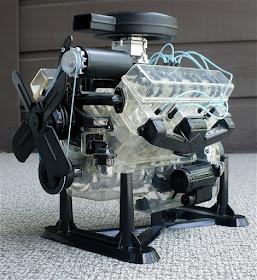There are few kits created from the late 50's early 60's and yet stand the test of time. This is one of them.
Of course back then it originally came with an electric motor to power the model. Today it only comes with a hand crank. Cheap bastards ;D
From Wikipedia"
A V8 engine is a V engine with eight cylinders mounted on the crankcase
in two banks of four cylinders, in most cases set at a right angle to
each other but sometimes at a narrower angle, with all eight pistons driving a common crankshaft.
In its simplest form, it is basically two straight-4 engines sharing a common crankshaft. However, this simple configuration, with a single-plane crankshaft, has the same secondary dynamic imbalance problems as two straight-4s, resulting in vibrations in large engine displacements. As a result, since the 1920s most V8s have used the somewhat more complex crossplane crankshaft with heavy counterweights to eliminate the vibrations. This results in an engine which is smoother than a V6, while being considerably less expensive than a V12 engine.
Most racing V8s continue to use the single plane crankshaft because it
allows faster acceleration and more efficient exhaust system designs.
In 1902, Léon Levavasseur took out a patent on a light but quite powerful gasoline injected V8 engine. He called it the 'Antoinette'
after the young daughter of his financial backer. From 1904 he
installed this engine in a number of competition speedboats and early
aircraft. The aviation pioneer Alberto Santos-Dumont saw one of these boats in Côte d'Azur and decided to try it on his 14-bis aircraft. Its early 24 hp (18 kW)
at 1400 rpm version with only 55 kg (120 lb) of weight was interesting,
but proved to be underpowered. Santos-Dumont ordered a larger and more
powerful version from Levavasseur. He changed its dimensions from the
original 80 mm stroke and 80 mm bore to 105 mm stroke and 110 mm bore,
obtaining 50 hp (37 kW) with 86 kg (190 lb) of weight, including cooling
water. Its power-to-weight ratio was not surpassed for 25 years.
Levavasseur eventually produced its own line of V-8 equipped aircraft,
named Antoinette I to VIII. One of these aircraft, piloted by Hubert Latham, twice tried but failed to cross the English Channel in 1909 due to the engine's gasoline injection.
However, in 1910, the same plane with the same engine and the same
pilot was first in the world to reach an altitude of 3600 feet. Voisin constructed pusher biplanes with Antoinette engines, also, notably the one first flown successfully by Henry Farman in 1908.
The V8 engine configuration became popular in France from 1904
onward, and was used in a number of aircraft engines introduced by Renault, and Buchet among others. Some of these engines found their way into automobiles in small quantities. In 1905, Darracq
built a special car to beat the world speed record. They came up with
two racing car engines built on a common crankcase and camshaft. The
result was monstrous engine with a displacement of 1,551 cu in (25,416
cc), good for 200 bhp (150 kW). Victor Hemery fixed that record on 30
December 1905 with a speed of 109.65 mph (176.46 km/h). This car still
exists.
Rolls-Royce built a 3,535 cc (216 cu in) V8 car from 1905 to 1906, but only 3 copies were made and Rolls-Royce reverted to a straight-6 design. De Dion-Bouton
introduced a 7,773 cc (474 cu in) automobile V8 in 1910 and displayed
it in New York in 1912. It was produced only in small quantities, but
inspired a number of American manufacturers to follow suit.
The first mass-production automobile V8 was introduced in the United States in 1914 by Cadillac, a division of General Motors
which sold 13,000 of the 5,429 cc (331 cu in) L-head engines in its
first year of production. Cadillac has been primarily a V8 company ever
since. Oldsmobile, another division of General Motors, introduced its own 4 L (244 cu in) V8 engine in 1916. Chevrolet
introduced a 288 cu in (4.7 L) V8 engine in 1917, but after merging
with General Motors in 1918, discontinued the V8 to concentrate on
economy cars.
In February 1915, Swiss automotive engineer Marc Birkigt designed the first example of the famous Hispano-Suiza V-8 single overhead cam
aviation engines, in differing displacements, using dual ignition
systems and in power levels from 150 horsepower to some 300 horsepower,
in both direct-drive and geared output shaft versions. Almost 50,000
"Hisso" V8 powerplants in total, as the engines became nicknamed, were
built in Spain, France, the United Kingdom, Italy and even by Wright Aeronautical in the United States during World War I, and are said to have powered roughly half of all Allied aircraft of the WW I era.






haven't seen one of these in a long time, did an engine way back when as one of my first's..great fun
ReplyDeleteThey still are.
ReplyDeleteI would love the RENWAL original version, specially for the nice illustration of the box. Can find it on Ebay but it's still a bit expensive...!
ReplyDeleteOld Model Kits .com has one for sale but it is expensive as well.
ReplyDeletehttp://www.oldmodelkits.com/index.php?detail=22341&manu=Renwal